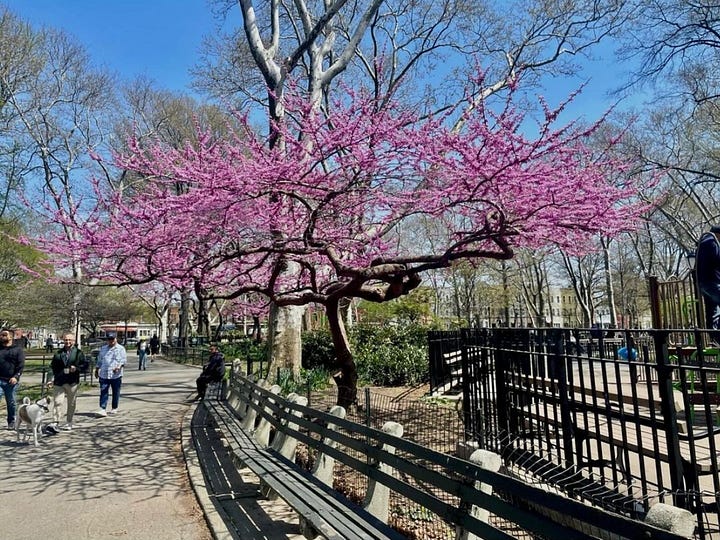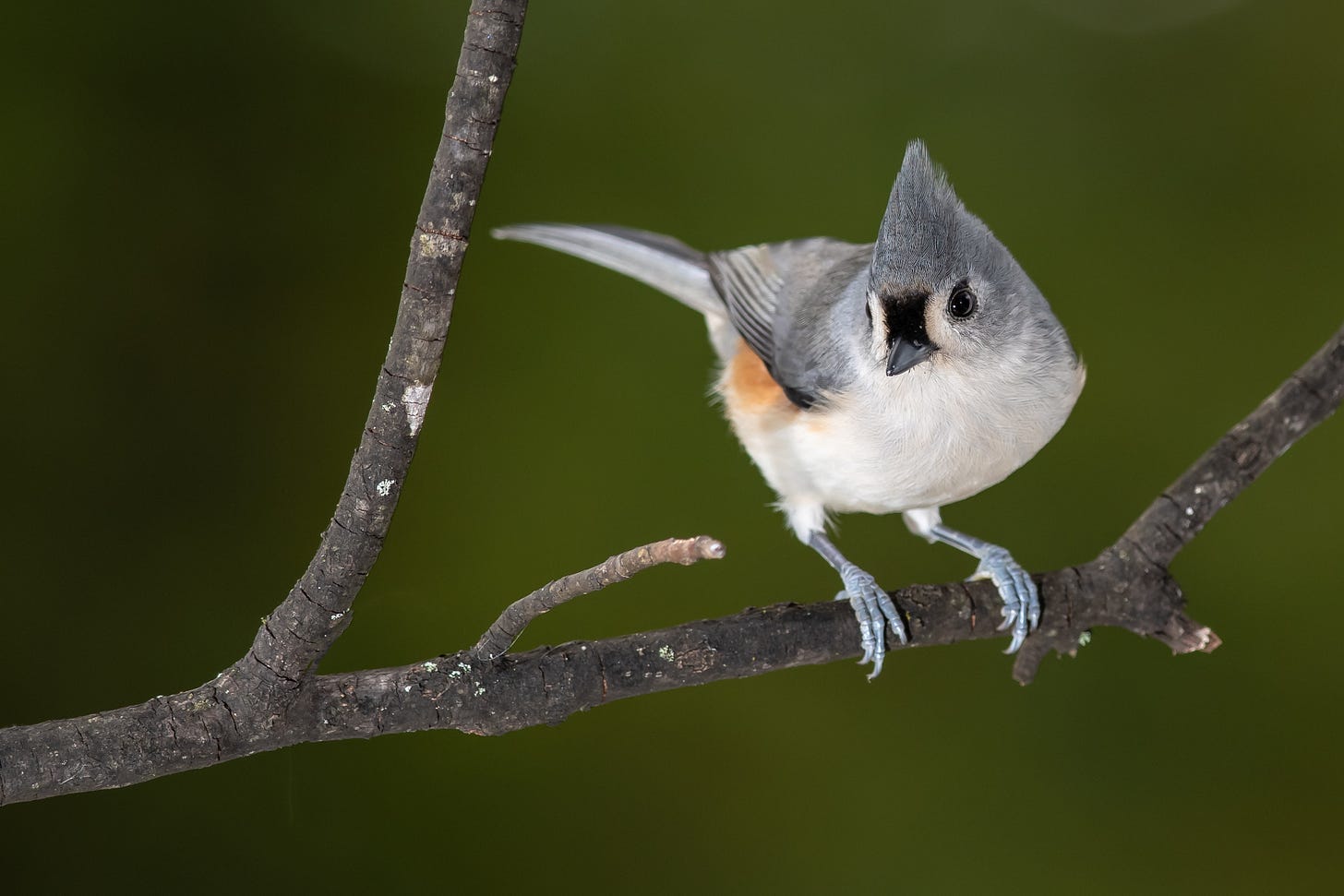MICRO-SEASON — OCT 7 - OCT 13
Mushroom people, Parisian planters, chicks and tits, great trees, sparrow lesson IRL, and more
This week a super-storm named Milton touched up Florida. It’s only natural to read related news then spin out ourselves. About the climate, about politics, about any number of awful possible futures.
Made us think of What If We Get It Right?, by Ayana Elizabeth Johnson. The book features Bren Smith, a commercial fisherman turned regenerative ocean farmer. Smith’s transformation was an adaptation. “After the cod stocks crashed in my home of Newfoundland, I was face-to-face with the reality that there would be no jobs on a dead planet.”
Smith cofounded the organization GreenWave, which is training thousands of people to grow seaweeds and oysters that help restore ocean life. He talks about today’s problems with a refreshing blue collar bent, and thinks there’s an opportunity to heal political division not through talking about the infuriatingly politicized climate crisis, but by noticing the “realities of the world and figuring out what to do”.
Skip the noise & notice the signal,
— Bird Club Studio
IN CASE YOU MISSED IT
Mycopeople at the Telluride Mushroom Festival!





Photos by @meteoriitta This annual event has been fruiting for forty-five 🍄 fungal filled 🍄 years!
What we talk about when we talk about rewilding:
Friends of McGolrick Park won its NYC Parks’ Great Trees of New York City nomination! Our Eastern Redbud is one of 61 new Great Trees.


Don’t forget to check out Day Owl’s beautiful bags made entirely of PFAS-free, recycled, landfill-bound materials. Get 20% off your first order via code MBCTITMOUSE20.
MICRO-SEASON OCT 7 - OCT 13
Unlike the arbitrary quarters of labor time made up by corporate humanoids, micro-seasons are straight from source, the great unity, the god-babe herself: Mama Natura.

Current Japanese micro-season: "Wild geese return". As for McGolrick Park, New York City and perhaps even larger swathes of the eastern US, we notice—
Tufted Titmice return · White Ashes shed · First of season White-breasted Nuthatch, Dark-eyed Junco, Song Sparrow, Winter Wren, Chipping Sparrow · Sweatshirts reappear · Leaves arrive in foyers
BIRD REPORT
Who’d we notice in McGolrick Park this micro-season?
Tufted Titmouse · Osprey · Gray-cheeked Thrush · Hermit Thrush · White-throated Sparrow · Eastern Towhee · Eastern Phoebe · White-breasted Nuthatch · Song Sparrow · Brown Creeper · Swamp Sparrow · Yellow-bellied Sapsucker · Cooper’s Hawk · Red-tailed Hawk · Blue-headed Vireo · Red-eyed Vireo · Winter Wren · Yellow-rumped Warbler · Blackpoll Warbler · American Redstart · Dark-eyed Junco · Chipping Sparrow · Northern Mockingbird · Common Yellowthroat · Ovenbird · Red-bellied Woodpecker · Canada Goose · Black-and-white Warbler · Scarlet Tanager · Ruby-crowned Kinglet · Golden-crowned Kinglet · Northern Flicker · Gray Catbird · American Kestrel · Cedar Waxwing · Downy Woodpecker · Blue Jay · Peregrine Falcon · Northern Cardinal · Common Grackle · American Crow · House Finch · Rock Pigeon · European Starling · American Robin · House Sparrow · Mourning Dove
Feel like you’re missing the migration gods’ missionaries? For the run of October, join us on Tuesday and Friday mornings, when birds are most active, starting around 7am. Just show up
Note that some of the above birds were seen wearing their “Female” plumage—what migrating birds of both sexes often sport in fall
MICRO-LESSON: PARIDAE FAMILY
You don’t need to know the name Paridae. You do need to know its bird types: titmice and chickadees.
Firstly, “tit” just means small bird in Old English. Take it easy.
Secondly, we hope to hang with two paridae species in NYC this winter:
Tufted Titmouse · Titmice have a gray, large black eyed, small billed, pointy headed lewk. The Tufted is the only eastern titmouse—the New Yorker. The others are found out west and down south.
Black-capped Chickadee · Though the adjective “cute” isn’t typically reverent enough for your correspondent, chickadees’ oversized round heads, tiny bodies, and curiosity about everything, including humans, makes the descriptor hard to resist.
Titmice and chickadees are active, noisy, and social. They’re highly adaptable, and besides corvids (crows and jays) and parrots, are among the smartest birds.
Case in point, chickadee calls, like the onomatopoeic chickadee-dee-dee, are linguistically complex, communicating info on other birds’ identities and as well as predators’ moves.
Not in NYC? Don’t chickadee-dee-dee-despair. (Sorry 😑.) A handful of titmouse and chickadee species can be found nationwide. Here are the five species of North American titmouse and the seven species of North American chickadee.

SPARROW LESSON IRL
Telling sparrow species apart is a subtle art akin to wine tasting.




Join us on Sunday, October 20th, at one of North Brooklyn’s best spots for sparrows.
We’ll commune with a number of species and—besides being punk, getting zen, having fun and munching on bagels, courtesy of Michael—learn how to tell these subtle beauties apart from one another with ease. Just show up at
Marsha P. Johnson State Park’s flower wreath gate, at N. 8th and Kent. We’ll start around 7:30am, and go wild until the energy fades.
Message us if you have any questions. And thanks so much for supporting our odd bird project, you beautiful primate, you.







